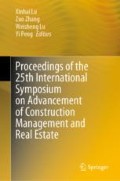Abstract
Exposure to severe temperatures is one of the critical effects on concrete damage. Additionally, the aggregate porosity (pores in the range of 0.1–0.5 μm) is the characteristic that influences freeze–thaw resistance due to the pore saturation resulting in the concrete deterioration. Freeze and thaw is a durability property which is the volumetric contraction and expansion of hardened concrete caused by abrupt temperature change in cold climes resulting in micro or macro cracks. The mechanism results in internal stresses, such as hydraulic pressure; osmotic pressure and pressure induced by the growth of crystals in pores and their interaction with pore walls. Additionally, this process causes internal relative humidity gradients within the cement paste matrix which leads to the reduction in concrete volume, i.e. drying shrinkage. The main aim of this study is to review the literature on procedures to evaluate freeze and thaw resistance of cycled aggregate in concrete, and some discussion on the treatments to enhance its durability has been included. The most relevant and cited paper in the Scopus and Web of Science databases were analysed to identify the effective treatments and mitigation processes to improve the resistance of recycled aggregate concrete under freeze and thaw cycles.
Access this chapter
Tax calculation will be finalised at checkout
Purchases are for personal use only
References
Abbas, A., et al. (2009). Durability of recycled aggregate concrete designed with equivalent mortar volume method. Cement and Concrete Composites, 31(8), 555–563. https://doi.org/10.1016/j.cemconcomp.2009.02.012
Alexandridou, C., Angelopoulos, G. N., & Coutelieris, F. A. (2018). Mechanical and durability performance of concrete produced with recycled aggregates from Greek construction and demolition waste plants. Journal of Cleaner Production, 176, 745–757. https://doi.org/10.1016/j.jclepro.2017.12.081
Bassani, M., & Tefa, L. (2018). Compaction and freeze–thaw degradation assessment of recycled aggregates from unseparated construction and demolition waste. Construction and Building Materials, 160, 180–195. https://doi.org/10.1016/j.conbuildmat.2017.11.052
Bogas, J. A., De Brito, J., & Ramos, D. (2016). Freeze–thaw resistance of concrete produced with fine recycled concrete aggregates. Journal of Cleaner Production, 115, 294–306. https://doi.org/10.1016/j.jclepro.2015.12.065
Butler, L., West, J. S., & Tighe, S. L. (2011). The effect of recycled concrete aggregate properties on the bond strength between RCA concrete and steel reinforcement. Cement and Concrete Research, 41(10), 1037–1049. https://doi.org/10.1016/j.cemconres.2011.06.004
Gokce, A., et al. (2011). Identification of frost-susceptible recycled concrete aggregates for durability of concrete. Construction and Building Materials, 25(5), 2426–2431. https://doi.org/10.1016/j.conbuildmat.2010.11.054
Guo, M.-Z., et al. (2015). Effects of recycled glass on properties of architectural mortar before and after exposure to elevated temperatures. Journal of Cleaner Production, 101, 158–164. https://doi.org/10.1016/j.cemconcomp.2015.04.017.
Hansen, T. C., & Henrik, N. (1983). Strength of recycled concrete made from crushed concrete coarse aggregate. Concrete International, 5(1).
Huda, S. B., & Alam, M. S. (2015). Mechanical and freeze–thaw durability properties of recycled aggregate concrete made with recycled coarse aggregate. Journal of Materials in Civil Engineering, 1–9. https://doi.org/10.1061/(ASCE)MT.1943-5533.0001237.
de Juan, M. S., & Gutiérrez, P. A. (2009). Study on the influence of attached mortar content on the properties of recycled concrete aggregate. Construction and Building Materials, 23(2), 872–877. https://doi.org/10.1016/j.conbuildmat.2008.04.012
Katz, A. (2003). Properties of concrete made with recycled aggregate from partially hydrated old concrete. Cement and Concrete Research, 33(5), 703–711. https://doi.org/10.1016/S0008-8846(02)01033-5
Kazmi, S. M. S., et al. (2020). Effect of different aggregate treatment techniques on the freeze–thaw and sulfate resistance of recycled aggregate concrete. Cold Regions Science and Technology, 178, 103126. https://doi.org/10.1016/j.coldregions.2020.103126.
Lei, B., et al. (2018). Durability of recycled aggregate concrete under coupling mechanical loading and freeze–thaw cycle in salt-solution. Construction and Building Materials, 163, 840–849. https://doi.org/10.1016/j.conbuildmat.2017.12.194
Li, Y., et al. (2018). Resistance of recycled aggregate concrete containing low- and high-volume fly ash against the combined action of freeze–thaw cycles and sulfate. Construction and Building Materials, 166, 23–34. https://doi.org/10.1016/j.conbuildmat.2018.01.084
Medina, C., Sánchez De Rojas, M. I., & Frías, M. (2013). Freeze–thaw durability of recycled concrete containing ceramic aggregate. Journal of Cleaner Production, 40, 151–160. https://doi.org/10.1016/j.jclepro.2012.08.042
Mehta, P., & Monteiro, P. J. M. (2005). Concrete: Microstructure, properties, and materials. McGraw-Hill (McGraw Hill Professional). Available from: https://books.google.com.au/books?id=GA5ZnxoRNiYC
Omary, S., Ghorbel, E., & Wardeh, G. (2016). Relationships between recycled concrete aggregates characteristics and recycled aggregates concretes properties. Construction and Building Materials, 108, 163–174. https://doi.org/10.1016/j.conbuildmat.2016.01.042.
Richardson, A., Coventry, K., & Bacon, J. (2011). Freeze/thaw durability of concrete with recycled demolition aggregate compared to virgin aggregate concrete. Journal of Cleaner Production, 19(2–3), 272–277. https://doi.org/10.1016/j.jclepro.2010.09.014
Tam, V. W. Y., Butera, A., & Le, K. N. (2018). Recycled aggregate in concrete production: A new approach. In Proceedings of the 21st International Symposium on Advancement of Construction Management and Real Estate, 2016 (209889) (pp. 1133–1139). https://doi.org/10.1007/978-981-10-6190-5_100.
Ujike, I. (2000). A study on air and water permeability of concrete using aggregate recycled from crushed concrete. In RILEM/CIB/ISO international symposium, Helsinki, FIN, 2000-05-22 (pp. 194–198). Available from: http://cat.inist.fr/?aModele=afficheN&cpsidt=14172024.
Wang, D., et al. (2017). Durability of concrete containing fly ash and silica fume against combined freezing–thawing and sulfate attack. Construction and Building Materials, 147, 398–406. https://doi.org/10.1016/j.conbuildmat.2017.04.172
Yildirim, S. T., Meyer, C., & Herfellner, S. (2015). Effects of internal curing on the strength, drying shrinkage and freeze–thaw resistance of concrete containing recycled concrete aggregates. Construction and Building Materials, 91, 288–296. https://doi.org/10.1016/j.conbuildmat.2015.05.045
Zaharieva, R., et al. (2003). Assessment of the surface permeation properties of recycled aggregate concrete. Cement and Concrete Composites, 25(2), 223–232. https://doi.org/10.1016/S0958-9465(02)00010-0
Author information
Authors and Affiliations
Editor information
Editors and Affiliations
Rights and permissions
Copyright information
© 2021 The Author(s), under exclusive license to Springer Nature Singapore Pte Ltd.
About this paper
Cite this paper
Tam, V.W.Y., Evangelista, A.C.J., Soomro, M. (2021). An Overview of Freeze and Thaw Cycles Affecting the Durability of Recycled Aggregate Concrete. In: Lu, X., Zhang, Z., Lu, W., Peng, Y. (eds) Proceedings of the 25th International Symposium on Advancement of Construction Management and Real Estate. CRIOCM 2020. Springer, Singapore. https://doi.org/10.1007/978-981-16-3587-8_4
Download citation
DOI: https://doi.org/10.1007/978-981-16-3587-8_4
Published:
Publisher Name: Springer, Singapore
Print ISBN: 978-981-16-3586-1
Online ISBN: 978-981-16-3587-8
eBook Packages: Business and ManagementBusiness and Management (R0)

